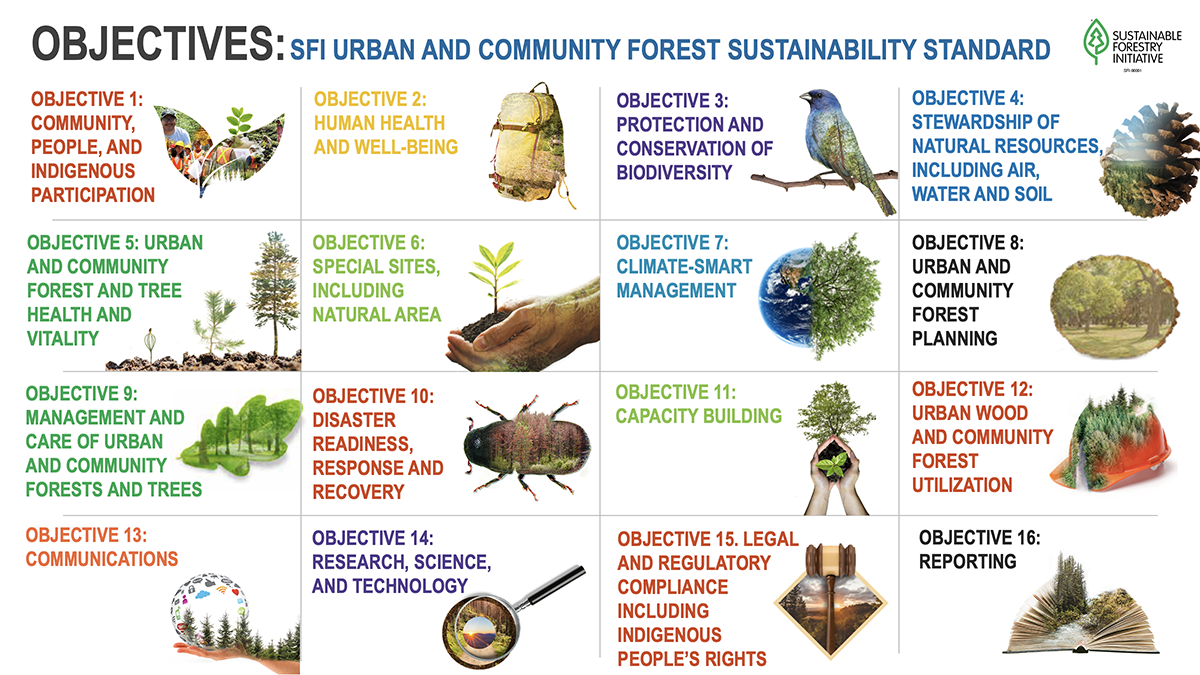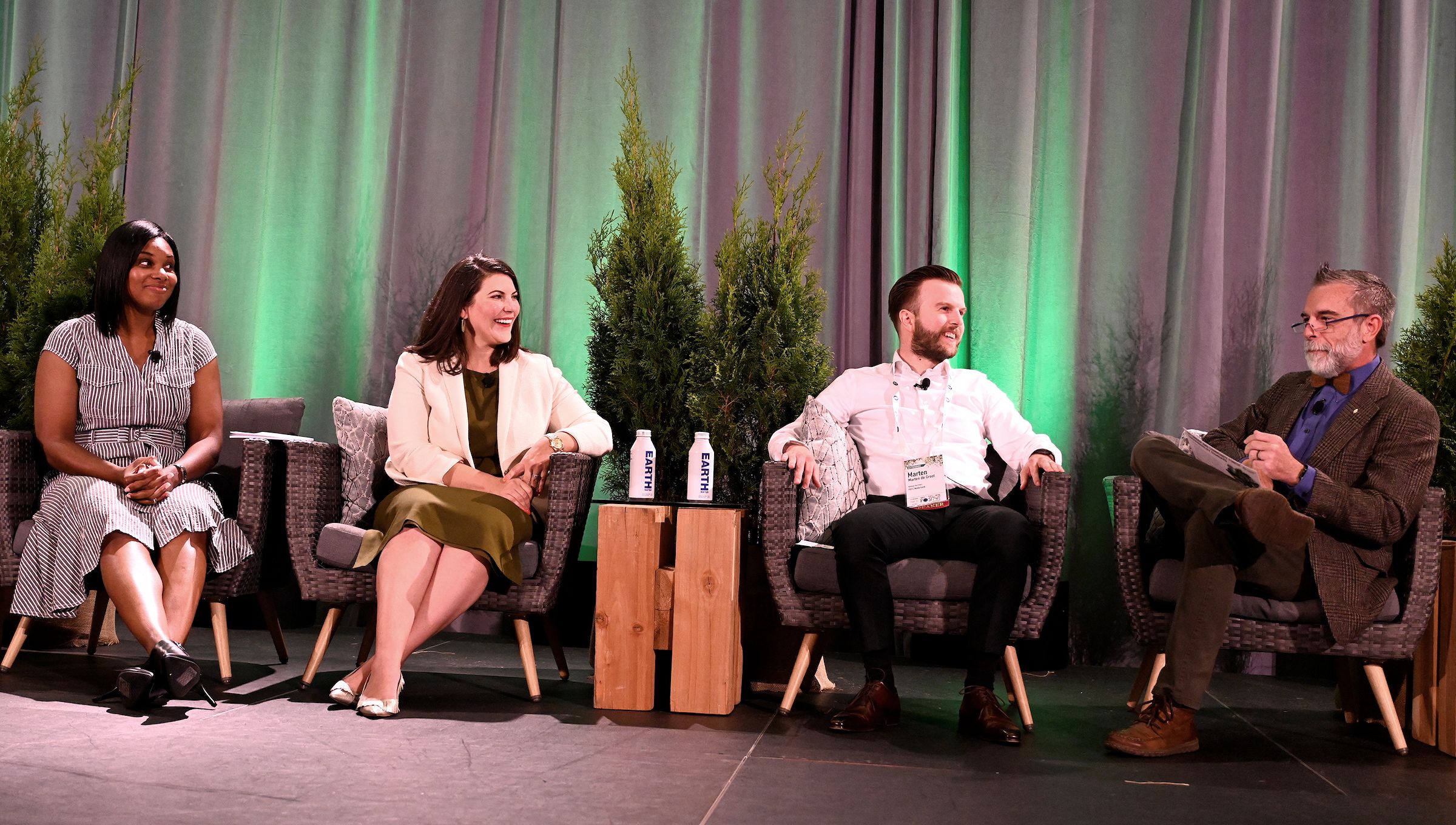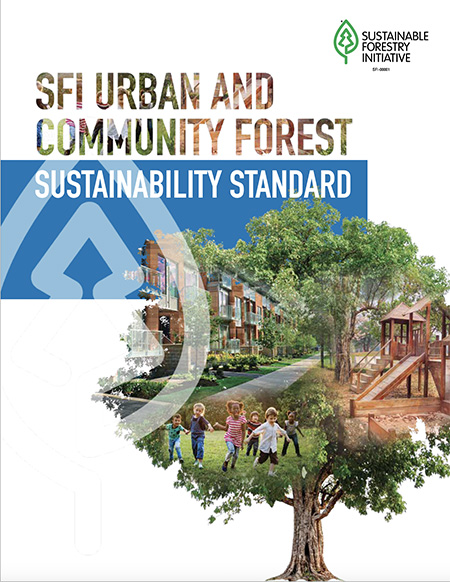Paul Johnson remembers the first tree he planted. Of course he does—he’s an urban forester with a passion for trees.
“It was outside the family home where I grew up,” he said. “Family legend has it that my father and I found a sprouted red oak acorn on a camping trip in southeastern Oklahoma when I was 18 months old. We took it home and planted it, and it grew there for more than 40 years.”
Until, some time after the Johnsons sold the home, the house caught fire, was later demolished, and the tree died. Johnson has a tattoo made from a photograph of a leaf from that tree.

Paul Johnson, the Sustainable Forestry Initiative’s Senior Director, Urban and Community Forestry, often wears a wooden bow tie.
Johnson also remembers the first tree he tried to cut down. On another camping trip, Johnson’s father made a stone hatchet for his son, then four or five years old. At home after the camping trip, the young Johnson did what you might expect a kid to do.
“I tried to cut down the family peach tree with that stone hatchet. That didn’t go over well with the family, of course,” Johnson said.
The tree remained standing but was so damaged that it died.
Johnson has always enjoyed being in the woods. He grew up in Tulsa, Oklahoma—Tulsa has been a Tree City USA for 30 years—and has fond memories of time spent hunting and fishing on and around his family’s property in southeastern Oklahoma. But forestry was not what he expected to be doing for the rest of his life. In high school, he thought he wanted to be a physicist. After high school, Johnson enrolled in the University of Oklahoma not as a physics major, but in a mathematics program, in part because, as a National Merit Scholar, a better scholarship was available.
“Honors Calculus III, at 8 o’clock in the morning Monday, Wednesday, and Friday, really kicked my butt. So I started looking around at some of the other options,” he said.
Johnson, whose mother was an actor and director, had himself been an actor since he was four years old and he performed in community theater productions through high school. So it wasn’t a big leap for Johnson to move from math to the university’s theater program. He also was confident that enrolling in the theater program would help him bring his grade point average up, which he needed to do in order to maintain his scholarship.
“I had grade point average of 1.77 after my first semester at the university, and I had to have a 3.25 GPA by the end of the school year,” he said.
After a successful spring semester and summer term with 26 hours of classes with a 4.0 GPA, Johnson ended up with a grade point average of 3.26.
But he knew that theater wasn’t what he wanted to do.
During the fall semester of his sophomore year, Johnson saw a movie that changed his life: A River Runs Through It. The 1992 film, a coming-of-age story based on the 1976 semi-autobiographical novella by Norman Maclean, is set in and around Missoula, Montana.
“There is a short montage in the movie where they mentioned the US Forest Service and working in forestry for the summer. That spurred me to have a conversation with my mom. She was getting a masters degree at Oklahoma State University, which had a forestry program, and she said, ‘Well, let’s go talk to them.’”
They did so, and Johnson switched schools, just in time for Oklahoma State’s next summer forestry camp, which happened to be held at the University of Montana’s Lubrecht Experimental Forest, just outside Missoula, Montana.
Johnson earned a bachelors degree in forestry and in the process met Rebecca, who was also enrolled in the Oklahoma State forestry program. The couple were married a few hours after their graduation ceremony and have been together ever since.
“I was her summer fling and she hasn’t figured out how to get rid of me yet,” he said, laughing.
Soon after graduation and their wedding, the Johnsons headed to Colorado, where they both had seasonal forestry jobs—Rebecca with the US Forest Service and Paul with the Colorado Forest Service. While she marked timber, Paul helped the state agency with Arbor Day celebrations, outdoor activities for youth, and assisting property owners with management plans.
Paul found that he enjoyed engaging with the public. Public speaking, he said, is one of his superpowers, and the theater background certainly helps.
“Teaching is one of the things I love to do,” Johnson said. “I have the ability to get up in front of a room full of people, engage with them, and help them understand whatever the topic is.”
After six months in Colorado, a couple returned to Oklahoma, where Paul began working for a landscaping company in McAllister, a city in the southeastern quadrant of the state.
Thus began Johnson’s career in urban and community forestry. After working in a variety of roles in urban forestry and landscaping services, in 2004 he took a position as a regional urban forester with the Texas Forest Service, based in San Antonio, and served as the agency’s urban and community forestry program leader, based in Austin, from 2012 to 2021. Johnson served as the International Society of Arboriculture’s president in 2019 and 2020. He joined the Sustainable Forestry Initiative (SFI) as Senior Director, Urban and Community Forestry, in 2021.
When Johnson first heard about the position with SFI, he applied almost on a whim. He had a good job and was happy with his work, but figured that it wouldn’t hurt to update his resume and go through the interview process. After the interview and talking to his colleagues about SFI, Johnson decided that the opportunity to participate in developing SFI’s Urban and Community Forest Sustainability Standard (UCFSS) was too good to pass up, even though it doubled his time to retirement.
Raising a Standard
After a two-year process involving ISA, American Forests, Tree Canada, the Arbor Day Foundation, the Society of Municipal Arborists, and numerous other organizations and individuals, the UCFSS was approved by SFI’s Board of Directors in May.
“The standard and the certifications that will come with it have the ability to really effect change, to have a true impact in urban and community forestry,” Johnson said. “For the past two decades or more I have been trying to figure out how to reach out to people better, to do a better job of balancing out the needs of people and trees. I think the standard is a great way to do just that. It’s going to make a real difference.”
The UCFSS’s guiding principles capture the motivation behind developing the standard:
- Urban and community forests and trees are vital for community well-being, health, resiliency, and sustainability.
- Urban and community forests and trees and their associated benefits should be accessible and available to everyone.
- Urban and community forests and trees depend upon understanding, awareness, appreciation, stewardship, and engagement by communities and people in order to thrive.
- Urban and community forests and trees require proper planning, care, and management to optimize benefits and minimize risks.
- Urban and community forests and trees are nature-based solutions to pressing issues and essential green infrastructure.

The guiding principles are reflected in 16 objectives:
Objective 1: Community, People, and Indigenous Participation
Objective 2: Human Health and Well-Being
Objective 3: Protection and Conservation of Biodiversity
Objective 4: Stewardship of Natural Resources, Including Air, Water, and Soil
Objective 5: Urban And Community Forest and Tree Health and Vitality
Objective 6: Special Sites, Including Natural Areas
Objective 7: Climate-Smart Management
Objective 8: Urban and Community Forest Planning
Objective 9: Management and Care of Urban and Community Forests and Trees
Objective 10: Disaster Readiness, Response, and Recovery
Objective 11: Capacity-Building
Objective 12: Urban Wood and Community Forest Utilization
Objective 13: Communications
Objective 14: Research, Science, and Technology
Objective 15: Legal and Regulatory Compliance, Including Indigenous Peoples’ Rights
Objective 16: Reporting
The standard is appropriate for organizations that own, manage, or are responsible for urban and/or community forests. These organizations can come from all facets of the urban and community forest sector, including, but not limited to: governmental organizations (i.e., municipalities, counties, states, provinces), non-governmental organizations, Indigenous Peoples, community groups, healthcare organizations, educational organizations, and corporate organizations. Third-party certification by a body that has been accredited by the ANSI National Accreditation Board or the Standards Council of Canada is required.
Because many organizations in urban and community forestry don’t have the resources necessary for third-party certification to the full UCFSS, SFI developed a thematic certification option though which a city, community, or organization can achieve third-party certification to one or more subsets of the objectives in the full standard that represent a certain theme:
- Community Well-Being and Human Health (a total of 30 indicators)
- Climate and Disaster Resilience (37 indicators)
- Environmental and Conservation Leadership (38 indicators)
- Urban Forest Improvement (44 indicators)
Such a standard is more important now than ever, Johnson said.

A panel discussion on urban forestry at the Sustainable Forestry Initiative’s annual conference in Vancouver, BC, in May 2023. Photo: SFI. Left to right: Sharon Jean-Philippe, professor of urban forestry, University of Tennessee; Caitlyn Pollihan, ISA CEO and Executive Director; Marten de Groot, National Secretary, PEFC Netherlands; and Paul Johnson, Senior Director, Urban and Community Forestry, the Sustainable Forestry Initiative.
“The standard is important because we have a sector that is relatively young,” Johnson said. “Now, communities have been doing urban forestry for as long as there have been communities, though it hasn’t been called urban forestry until fairly recently. The term wasn’t even coined until the 1960s, and there wasn’t a federal program supporting urban forestry until the Farm Bill in 1990. And until now, there hasn’t been a standard for urban forestry. If you ask people how to do urban forestry, you’ll get at least as many answers as people that you ask.”
Johnson noted that the Clark-Matheny Model for assessing urban forestry programs was an important first step. The model was described in a 1997 Journal of Arboriculture paper by James R. Clark, Nelda P. Matheny, Genni Cross, and Victoria Wake, “A Model of Urban Forest Sustainability.”
“And then the US Forest Service came up with an urban forest audit program that said, ’OK, if you have an urban forestry program, here are the things that you should be able to do.’ It was a great way to audit an individual program, but not the urban forest as a whole,” said Johnson. “Plus, over the last 10 or 15 years there’s been more and more research on ecosystem values and the connection between urban forests and human health, and our knowledge in these areas just keeps growing by leaps and bounds. It’s getting to the point now where it’s no longer just correlation studies, but there’s actual peer-reviewed research showing causation, showing how trees actually have an impact on human health. Combine that with efforts to mitigate and adapt to climate change and the significant federal investments being made in that area, there’s just never been a better time to be in urban and community forestry. I’m almost envious that my colleague Alix Olson is at the beginning of her career, at a time when there are going to be so many opportunities that we’ve never really had before, opportunities to reach out to people we haven’t engaged with before.”
Olson, SFI’s Urban and Community Forestry Coordinator, recently became an ISA Certified Arborist.
Urban forestry programs in cities impact millions of people in the US and Canada, Johnson said.
“That’s the idea with this standard. It’s going to impact communities in at least two countries—and may have impacts in other countries, whether it’s direct or ancillary impacts,” he said. “It’s been very satisfying to take the latest and greatest research and knowledge on how we can help trees survive and thrive in our communities, and to work on a standard that will have an immediate impact on that environment.”
Johnson cited research by the Green Heart Louisville project in Kentucky that assesses the positive impacts of urban forests.
“This research shows that there are immediate improvements in air quality if trees are planted around a school. Usually we talk about the impacts coming many years down the road. By using bigger trees, using rough-leafed evergreens to maximize the impact, the researchers set up air-quality sensors on a Friday, planted the trees on Saturday, and the air quality immediately improved. That’s huge! If you can have that kind of an impact so quickly, and then you add in the value of shade in the summer and all the other values of urban forests, we can have a direct and major impact on people, using trees as the medium that we work with.”
Arborists and urban foresters know very well that these professions involve much more than trees.
“It’s all about trees and people. Or people and trees, depending on which way you come at it. That’s what’s so unique about urban forestry. It’s still silviculture, whether you want to call it that in an urban setting or not—it’s biology, it’s the science of trees and how they grow. But it’s also the intersection between so many trees and people, and that makes it a unique environment. Urban forestry maximizes the benefits and minimizes the risks of urban trees. And that’s baked into the standard itself.”
The development of the UCFSS is an important step for SFI, but Johnson sees the bigger picture.
“I see 2023 as an inflection point for urban and community forestry. We have had the opportunity to be a part of that inflection point,” he said. “It comes down to wanting to make a difference. It’s the cause more than the organization. And we have a really important cause.”

